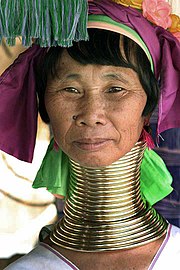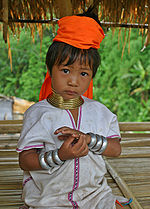| This article needs additional citations for verification. Please help improve this article by adding citations to reliable sources. Unsourced material may be challenged and removed. Find sources: "Neck ring" – news · newspapers · books · scholar · JSTOR (April 2023) (Learn how and when to remove this message) |


Neck rings, or neck-rings, are any form of stiff jewellery worn as an ornament around the neck of an individual, as opposed to a loose necklace. Many cultures and periods have made neck rings, with both males and females wearing them at various times.
Of the two most notable types, one is the torc, an often heavy and valuable ornament normally open at the throat. These were worn by various early cultures but are especially associated with the ancient Celts of the European Iron Age, where they were evidently a key indicator of wealth and status, mostly worn by men.
The other type is one or more spiral metal coils of many turns, often worn only by married women.
Illusion of elongation
| This section needs additional citations for verification. Please help improve this article by adding citations to reliable sources in this section. Unsourced material may be challenged and removed. Find sources: "Neck ring" – news · newspapers · books · scholar · JSTOR (January 2025) (Learn how and when to remove this message) |
In a few African and Asian cultures, neck rings are worn usually to create the appearance that the neck has been stretched.
The custom of wearing neck rings is related to an ideal of beauty: an elongated neck. Neck rings push the clavicle and ribs down. The neck stretching is mostly illusory: the weight of the rings twists the collarbone and eventually the upper ribs at an angle 45 degrees lower than what is natural, causing the illusion of an elongated neck. The vertebrae do not elongate, though the space between them may increase as the intervertebral discs absorb liquid.
The custom requires that the girls who wear the neck rings start before puberty, in order to get the body used to them. These heavy coils can weigh as much as 11 pounds (5 kg).
Role of tourism
Tourism is often considered to encourage the use of neck rings in Myanmar, as they are a popular attraction for tourists.
Kayan

Padaung (Kayan Lahwi) women of the Kayan people begin to wear neck coils from as young as age two. The length of the coil is gradually increased to as much as twenty turns. The weight of the coils will eventually place sufficient pressure on the clavicles (collarbone) to cause them to deform and create an impression of a longer neck.
Small Kayan girls may wear brass collars from the age of two to five years old, as it is more comfortable to deform the collarbone and upper ribs slowly. The alternative, an accelerated process at around the age of twelve, when girls first begin to compete for the attention of boys, is painful. Marco Polo first described the practice to Western culture in c. 1300. Refugee practitioners in Thailand were first accessible to tourists in 1984.
Ndebele

The South Ndebele peoples of Africa also wear neck rings as part of their traditional dress and as a sign of wealth and status. Only married women are allowed to wear the rings, called dzilla. Metal rings are also worn on different parts of the body, not just the neck. Traditionally these rings are given to a wife by her husband, and not removed until the husband's death; however, these rings are individual and do not function as a body modification. The rings are usually made of copper or brass, usually stacked in multiples of three.
See also
- Foot binding
- Genital cutting (disambiguation)
- Genital modification and mutilation
- Body modification
- Stretching (body piercing)
- Body piercing
References
- ^ Burmese women in Thai 'human zoo'. BBC News. (January 2008)
- Andrew Walker (16 May 2007). "Bound by tradition". New Mandala.
- Padaung National Geographic film
- Vuk'uzenzele, November 2007
- The clothing and accessories of the Ndebele, February 2017
External links
- Page about Karen tradition
- Page about Kayan Lahwi neck rings
- Padaung National Geographic film